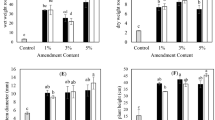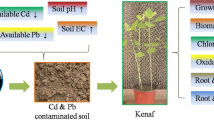Abstract
The potential of kenaf (Hibiscus cannabinus L.) and corn (Zea mays L.) for accumulation of cadmium and zinc was investigated. Plants have been grown in lysimetres containing dredging sludge, a substratum naturally rich in trace metals. Biomass production was determined. Sludge and water percolating from lysimeters were analyzed by atomic absorption spectrometry. No visible symptoms of toxicity were observed during the three- month culture. Kenaf and corn tolerate trace metals content in sludge. Results showed that Zn and Cd were found in corn and kenaf shoots at different levels, 2.49 mg/kg of Cd and 82.5 mg/kg of Zn in kenaf shoots and 2.1 mg/kg of Cd and 10.19 mg/kg in corn shoots. Quantities of extracted trace metals showed that decontamination of Zn and Cd polluted substrates is possible by corn and kenaf crops. Tolerance and bioaccumulation factors indicated that both species could be used in phytoremediation.
Similar content being viewed by others
References
Alexander PD, Alloway BJ, Dourado AM (2006) Genotypic variations in the accumulation of Cd, Cu, Pb and Zn exhibited by six commonly grown vegetables. Environ Pollut 144(3):736–745
Alkorta I, Hernandez-Allica J, Becerril JM, Amezaga I, Albizu I, Garbisu C (2004) Recent findings on the phytoremediation of soils contaminated with environmentally toxic heavy metals and metalloids such as zinc, cadmium, lead and arsenic. Environ Sci Biotechnol 3:71–90
Alloway BJ (1995) Soil processes and the behavior of metals. In: Alloway BJ (ed) Heavy metals in: soils. Blackie and Sons Limited, Glasgow, pp 1–52
Baba SB, Raji KA (2010) Phytoremediation potential of kenaf (Hibiscus cannabinus L.) grown in different soil textures and cadmium concentrations. Afr J Environ Sci Technol 4:250–255
Ben Ghnaya A (2006) Phytoremédiation : apport de la sélection in vitro pour l’obtention de Colza (Brassica napus L.) tolérant aux métaux toxiques. Geo Eco Trop 30:69–86
Bingham FT, Page AL, Mahler RJ, Ganje TJ (1975) Growth and cadmium accumulation of plants grown on a soil treated with a cadmium enriched sewage sludge. J Environ Qual 4:207–211
Cartoga A, Fernando A, Oliveira JS (2005) Effects on growth, productivity and biomass quality of kenaf of soils contaminated with heavy metals. Sci Ref Cosmos 4:1–4
Chaney RL, Malik M, Li YM, Brown SL, Brewer GP, Baker AJM (1997) Phytoremediation of soil metal. Curr Opin Biotechnol 18:279–284
Cieslinski G, Van Rees KCJ, Huang PM, Kozak LM, Rostad HPW, Knott DR (1996) Cadmium uptake and bioaccumulation in selected cultivars of durum wheat and flax as affected by soil type. Plant Soil 182(1):115–124
Das P, Samantaray S, Rout GR (1997) Studies on cadmium toxicity in plants. A review. Environ Pollut 98:29–36
Daud MK, Sun YQ, Dawood M, Hayat Y, Variath MT, Wu YX, Raziuddin Mishkat U, Alahuddin Najeeb U, Zhu SJ (2009) Cadmium-induced functional and ultrastructural alterations in roots of two transgenic cotton cultivars. J Hazard Mater 161(1):463–473
Guo XF, Wei ZB, Wu QT, Qiu JR, Zhou JL (2011) Cadmium and zinc accumulation in maize grain as affected by cultivars and chemical fixation amendments. Pedosphere 21(5):650–656
Hinesly TD, Alexander DE, Ziegler EL, Barrett GL (1978) Zinc and Cd accumulation by corn inbreds grown on sludge amended soil. Agron J 70:425–428
Huang XD, El-Alawi Y, Gurska J, Glick BR, Greenberg BM (2005) A multi-process phytoremediation system for decontamination of persistent total petroleum hydrocarbons (TPHs) from soils. Microchem J 81:139–147
Kimenyu PN, Oyaro N, Chacha JS, Tsanuo MK (2009) The potential of Commelina bengalensis, Amaranthus hybridus, Zea mays for phytoremediation of heavy metals from contaminated soils. Sains Malays 38:61–68
Lockwood MP (1976) Effects of pollutants on aquatic organisms. Cambridge University Press, New York
Máthé-Gáspár G, Anton A (2005) Phytoremediation study: factors influencing heavy metal uptake of plants. Acta Biol Szegediensis 49:69–70
Mojiri A (2011) The potential of corn (Zea mays) for phytoremediation of soil contaminated with cadmium and lead. J Biol Environ sci 5:17–22
Nabulo G, Black CR, Young SD (2011) Trace metal uptake by tropical vegetables grown on soil amended with urban sewage sludge. Environ Pollut 15:368–376
Pečiulytė D, Repečkienė J, Levinskaitė L, Lugauskas A, Motuzas A, Prosyčevas I (2006) Growth and metal accumulation ability of plants in soil polluted with Cu, Zn and Pb. Ekologija 1:48–52
Raskin I, Kumar NPBA, Dushenkov S, Salt DE (1994) Bioconcentration of heavy metal by plants. Curr Opin Biotechnol 5:285–290
Salt DE, Blaylock M, Kumar NPBA, Dushenkov V, Ensley BD, Chet I, Raskin I (1995) Phytoremediation : a novel strategy for the removal of toxic metals from the environment using plants. Biotechnology 13:468–474
Santos GCG, Rodella AA, Abreu CA, Coscione AR (2010) Vegetable species for phytoextraction of boron, copper, lead, manganese and zinc from contaminated soil. SciELO Brasil 67:713–719
Wagner GJ (1993) Accumulation of cadmium in crop plants and its consequences to human health. Adv Agron 51:173–212
Webber C, Harbans L, Venita K (2002) Kenaf production: fiber, feed and seed. In: Janick J, Whipkey A (eds) Trends in new crops and new uses, vol 13. ASHS Press, Alexandria, pp 327–339
Wu FB, Zhang GP, Dominy P, Wu HX, Bachir DML (2007) Differences in yield components and kernel Cd accumulation in response to Cd toxicity in four barley genotypes. Chemosphere 70(1):83–92
Wuana RA, Okieimen FE (2010) Phytoremediation potential of Maize (Zea mays L.). A Review. Afr J Gen Agric 6:275–287
Author information
Authors and Affiliations
Corresponding author
Rights and permissions
About this article
Cite this article
Arbaoui, S., Evlard, A., Mhamdi, M.E.W. et al. Potential of kenaf (Hibiscus cannabinus L.) and corn (Zea mays L.) for phytoremediation of dredging sludge contaminated by trace metals. Biodegradation 24, 563–567 (2013). https://doi.org/10.1007/s10532-013-9626-5
Received:
Accepted:
Published:
Issue Date:
DOI: https://doi.org/10.1007/s10532-013-9626-5




